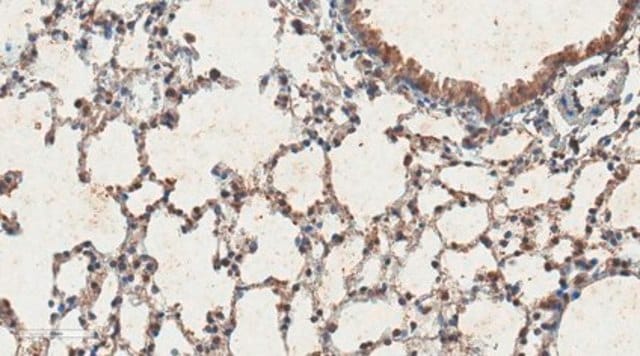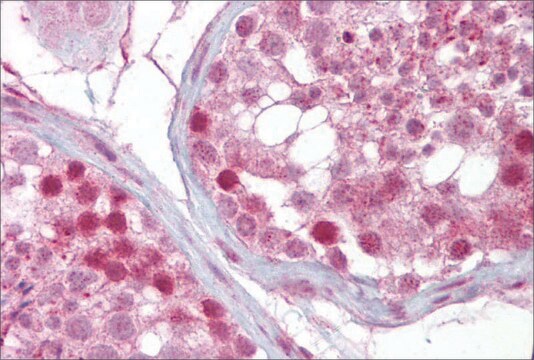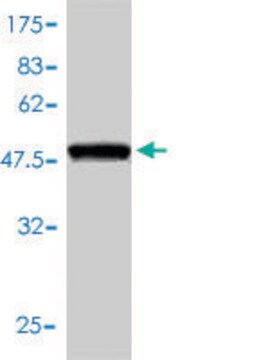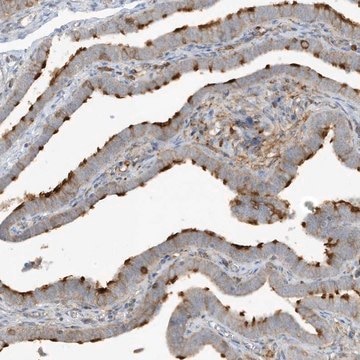ABC932
Anti-IFT88 Antibody
serum, from rabbit
Synonyme(s) :
Intraflagellar transport protein 88 homolog, Polaris, Recessive polycystic kidney disease protein Tg737, Tetratricopeptide repeat protein 10, TgN(Imorpk)737Rpw, TPR repeat protein 10
About This Item
Produits recommandés
Source biologique
rabbit
Niveau de qualité
Forme d'anticorps
serum
Type de produit anticorps
primary antibodies
Clone
polyclonal
Espèces réactives
rat, human, mouse
Réactivité de l'espèce (prédite par homologie)
bovine (based on 100% sequence homology)
Technique(s)
electron microscopy: suitable
immunocytochemistry: suitable
immunofluorescence: suitable
western blot: suitable
Numéro d'accès NCBI
Numéro d'accès UniProt
Conditions d'expédition
dry ice
Modification post-traductionnelle de la cible
unmodified
Informations sur le gène
bovine ... Ift88(514177)
human ... IFT88(8100)
mouse ... Ift88(21821)
rat ... Ift88(305918)
Description générale
Spécificité
Immunogène
Application
Western Blotting Analysis: A representative lot detected a greatly reduced Tg737/Polaris expression in lysate from E11.5 mouse embryo limbs with conditional mesenchymal Ift88-knockout (prx1cre;Ift88fl/n) when compared with lysate from a wild-type littermate (Haycraft, C.J., et al. (2007). Development. 134(2):307-316).
Immunocytochemistry Analysis: A representative lot detected IFT88 (Tg737/Polaris) cellular localization in paraformaldehyde-fixed rat and murine sperm cells, rat round spermatids, as well as elongating spermatids from Ift88 mutant mice (Kierszenbaum, A.L., et al. (2011). Dev. Dyn. 240(3):723-736).
Immunocytochemistry Analysis: A representative lot detected Tg737/Polaris immunoreactivity associated with the cilium of cultured limb bud cells isolated from wild-type mouse E11.5 embryos by fluorescent immunocytochemistry, while cilia were absent in cells from Tg737Δ2–3β-gal embryos (Haycraft, C.J., et al. (2005). PLoS Genet. 1(4):e53).
Electron Microscopy Analysis: A representative lot detected IFT88 (Tg737/Polaris) localization in rat round spermatids and fractionated manchettes (Kierszenbaum, A.L., et al. (2011). Dev. Dyn. 240(3):723-736).
Immunofluorescence Analysis: A representative lot detected polaris immunoreactivity in both dental epithelium (DE) and dental mesenchyme (DM) of lower molar frontal sections from E13.5 and E16.5 embryonic mice (Ohazama, A., et al. (2009). Development. 136(6):897-903).
Immunofluorescence Analysis: A representative lot immunostained primary cilium on epithelial and mesenchymal cells of the skin and hair follicle using OCT-embedded frozen skin sections from both mouse embryos and adult mice (Lehman, J.M., et al. (2009). J. Invest. Dermatol. 129(2):438-448).
Immunofluorescence Analysis: A representative lot detected Ift88 (Tg737/Polaris) immunoreactivity enriched at the base and tip of the hair cell (HC) kinocilia in the ciliary axonemes by fluorescent immunohistochemistry using 4% paraformaldehyde-fixed inner ear cochlear whole mounts prepared from mouse E14.5 embryos (Jones, C., et al. (2008). Nat. Genet. 40(1):69-77).
Immunofluorescence Analysis: A representative lot immunostained cilium in mesenchymal and ectodermal cells in formaldehye-fixed, OCT-embedded frozen limb bud sections from mouse E11.5 embryos by fluorescent immunohistochemistry. Conditional mesenchymal Ift88-knockout (prx1cre;Ift88fl/n) selectively abolished Tg737/Polaris immunoreactivity in the mesenchyme, but not the ectoderm layer (Haycraft, C.J., et al. (2007). Development. 134(2):307-316).
Immunofluorescence Analysis: A representative lot detected Tg737/Polaris immunoreactivity at the base and distal tip of cilium in mesenchymal and ectodermal cells in OCT-embedded frozen limb bud sections from mouse E10.5 embryos by fluorescent immunohistochemistry (Haycraft, C.J., et al. (2005). PLoS Genet. 1(4):e53).
Apoptosis & Cancer
Developmental Signaling
Qualité
Western Blotting Analysis: A 1:200 dilution of this antibody detected IFT88 in 50 µg of mouse kidney tissue lysate.
Description de la cible
Forme physique
Stockage et stabilité
Handling Recommendations: Upon receipt and prior to removing the cap, centrifuge the vial and gently mix the solution. Aliquot into microcentrifuge tubes and store at -20°C. Avoid repeated freeze/thaw cycles, which may damage IgG and affect product performance.
Autres remarques
Clause de non-responsabilité
Not finding the right product?
Try our Outil de sélection de produits.
Code de la classe de stockage
12 - Non Combustible Liquids
Classe de danger pour l'eau (WGK)
WGK 1
Point d'éclair (°F)
Not applicable
Point d'éclair (°C)
Not applicable
Certificats d'analyse (COA)
Recherchez un Certificats d'analyse (COA) en saisissant le numéro de lot du produit. Les numéros de lot figurent sur l'étiquette du produit après les mots "Lot" ou "Batch".
Déjà en possession de ce produit ?
Retrouvez la documentation relative aux produits que vous avez récemment achetés dans la Bibliothèque de documents.
Notre équipe de scientifiques dispose d'une expérience dans tous les secteurs de la recherche, notamment en sciences de la vie, science des matériaux, synthèse chimique, chromatographie, analyse et dans de nombreux autres domaines..
Contacter notre Service technique








